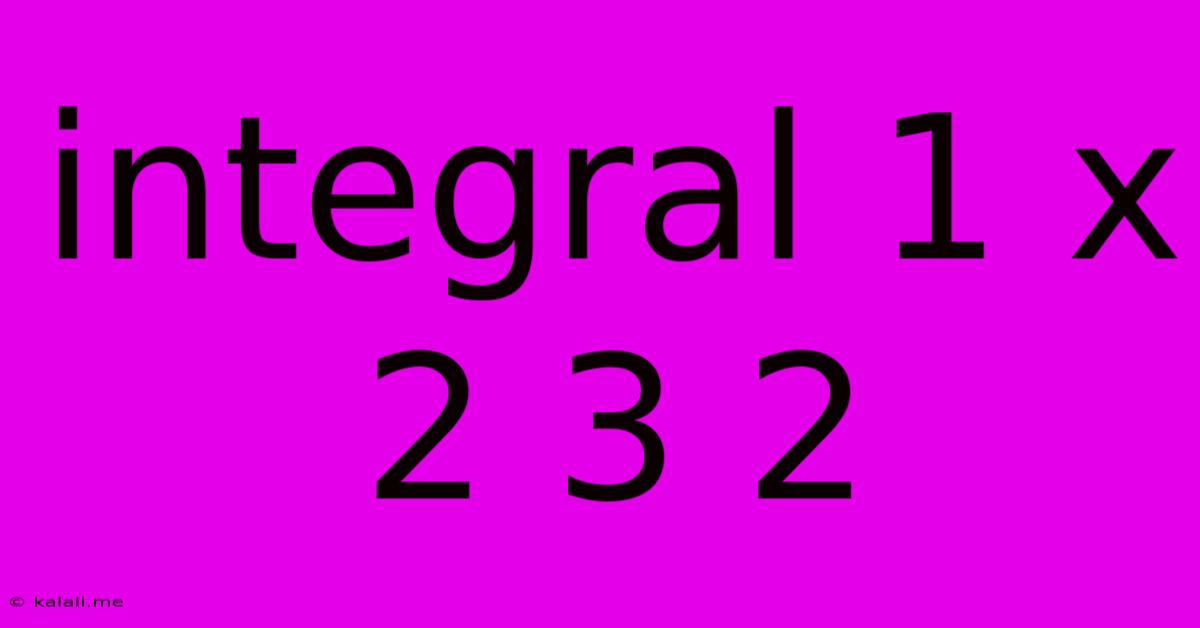Integral 1 X 2 3 2
Kalali
May 30, 2025 · 2 min read

Table of Contents
Understanding and Solving the Integral: ∫x^(2/3) dx
This article will guide you through understanding and solving the definite integral ∫x^(2/3) dx. We'll cover the fundamental concepts, the step-by-step solution, and some practical applications. Understanding this type of integral is crucial for calculus students and anyone working with mathematical modeling in various fields.
What is an Integral?
In simple terms, an integral is the reverse process of differentiation. Differentiation finds the rate of change of a function, while integration finds the area under the curve of a function. This area represents the accumulation of the function over a given interval. The integral ∫x^(2/3) dx represents finding the area under the curve of the function f(x) = x^(2/3).
Solving the Indefinite Integral ∫x^(2/3) dx
To solve this integral, we'll utilize the power rule of integration, which states:
∫xⁿ dx = (xⁿ⁺¹)/(n+1) + C
where 'n' is any real number except -1, and 'C' is the constant of integration.
Let's apply this rule to our integral:
-
Identify 'n': In our integral, ∫x^(2/3) dx, n = 2/3.
-
Apply the power rule:
∫x^(2/3) dx = (x^(2/3 + 1))/(2/3 + 1) + C
-
Simplify the exponent:
2/3 + 1 = 5/3
-
Simplify the expression:
(x^(5/3))/(5/3) + C = (3/5)x^(5/3) + C
Therefore, the indefinite integral of x^(2/3) is (3/5)x^(5/3) + C. The constant of integration, 'C', is crucial because the derivative of a constant is always zero. This means multiple functions can have the same derivative.
Solving a Definite Integral (with Limits)
If we were given limits of integration (e.g., from a to b), we would evaluate the definite integral as follows:
∫[from a to b] x^(2/3) dx = [(3/5)x^(5/3)] [from a to b] = (3/5)b^(5/3) - (3/5)a^(5/3)
This would give us a numerical value representing the area under the curve between points 'a' and 'b'.
Applications of this Integral
This type of integral appears in various applications, including:
- Calculating areas: As mentioned earlier, it directly calculates the area under the curve of the function x^(2/3).
- Physics: It can be used to model physical phenomena involving fractional powers, like certain types of growth or decay processes.
- Engineering: In engineering, it could be used in calculations related to stress, strain, or other physical properties described by power functions.
Conclusion
Solving the integral ∫x^(2/3) dx involves applying the power rule of integration. The solution is (3/5)x^(5/3) + C, where C is the constant of integration. Understanding this basic integral is a stepping stone to mastering more complex integration techniques and applying them to various real-world problems. Remember to always consider the constant of integration in indefinite integrals and evaluate the antiderivative at the limits for definite integrals.
Latest Posts
Latest Posts
-
When A Creature Enters The Battlefield
May 31, 2025
-
Brake To Give It The Beans
May 31, 2025
-
How To Read Left Hand Piano
May 31, 2025
-
The Way Of The Transgressor Is Hard
May 31, 2025
-
What Is D3 On A Honda Civic
May 31, 2025
Related Post
Thank you for visiting our website which covers about Integral 1 X 2 3 2 . We hope the information provided has been useful to you. Feel free to contact us if you have any questions or need further assistance. See you next time and don't miss to bookmark.